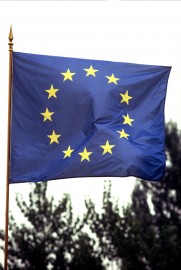
The Young European Federalists are launching a campaign complaining at the loss of the European flag from the Reform Treaty. You can read about their campaign here: http://www.communicate-europe.co.uk/fileadmin/files_jef-europe/JEF_Documents/Leaflet_FLAG_new.pdf
A nice idea for campaign, maybe, but I don’t think I agree with it.
Partly it’s a personal thing. Symbols of that kind don’t mean much to me anyway. I turn the sound down if there are national anthems on the TV before international football matches. I don’t feel particularly stirred by the sight of a national flag. It’s a logo. It’s a shorthand for the country but not more than that. So the loss of the flag from the treaties doesn’t trouble me.
Secondly, on a more objective basis, there were good reasons for removing the flag from the treaty.
On the one hand, including features such as the flag and the anthem in the treaty gave the impression that the EU was set on acquiring state-like features in a way that disturbed some of the voters. Cooperation in the detailed manner set out in the constitutional treaty, yes; high-flown ambitions, no. The success of the Monnet method is based on satisfying immediate needs in Europe in a manner consistent with meeting longer-term objectives but actually separate from them. Maybe the inclusion of the flag and the anthem blurred the difference between the short term and the long term in an unhelpful way.
On the other hand, there were voters for whom the inclusion of the flag and the anthem was not a provocation but a disappointment. It was not matched by all the other features of a developing European state-like system: foreign policy decision-making remains based on unanimity, for example, and there remains no European taxation system worthy of the name. Their complaint was not that the EU should not have a flag, but that it does not deserve a flag.
The final reason for doubting the merits of this campaign is that the flag itself has not disappeared. You still find it flying outside EU official buildings, treaty provision or not. A campaign demanding the return of the EU flag in that sense has nothing to achieve.
FT columnist Gideon Rachman remarked after the summit in June that this is exactly what is wrong with the EU – the treaty is changed as a sop to the voters but everything just carries on as before – but I think it shows something important about the underlying nature of the EU. The use of the flag and the other symbols does not arise from a top-down instruction from the treaty, but as a result of people seeking to be identified as European. So many European associations and organisations of all kinds have adopted the stars, or a blue and gold colour scheme, because that it is what Europe looks like. (Here is the logo of the Ryder Cup, for example: http://www.rcts.co.uk/rydercup2008/index.html.)
The treaties don’t have to tell us to be European, if that is how we really feel, and if we don’t actually feel European, there is little that the treaties can do to make us.
